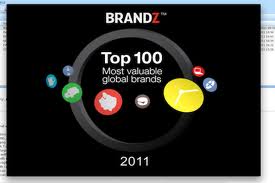 Apple has supplanted Google as the world’s #1 most valuable brand, worth more brand-wise than Microsoft and Coca-Cola combined (#5 and #6). the other most valuable global brands are IBM, McDonalds, AT&T, Marlboro, China Mobile, and GE. Technology brands have significantly grown in value with consumers allocating more personal disposable income to products like tablet computers and smartphones, even in the face of recessionary economics the world over. Technology companies are now 1/3 of the top 100 brands.
Apple has supplanted Google as the world’s #1 most valuable brand, worth more brand-wise than Microsoft and Coca-Cola combined (#5 and #6). the other most valuable global brands are IBM, McDonalds, AT&T, Marlboro, China Mobile, and GE. Technology brands have significantly grown in value with consumers allocating more personal disposable income to products like tablet computers and smartphones, even in the face of recessionary economics the world over. Technology companies are now 1/3 of the top 100 brands.
Millward Brown, the brand consultancy that is part of WPP, the global communications firm, has conducted the BrandZ top 100 most valuable global brand study for 6 years.
The BrandZ analysis covers 13 consumer-facing categories: apparel, beer, cars, fast food, financial institutions, insurance, luxury goods, oil and gas, personal care, retail, soft drinks, technology, and telecommunications. “Health” and “health care” are not specifically explored. However, Millward Brown does tease out health implications in several categories.
Overall, Millward Brown identified four new media meta-messages:
- Assertion of individuality, where personal expression enabled by the Internet is translating to consumers’ preferences for personal expression in consumer goods such as clothing.
- Concern about the environment, where consumers’ “green-ness’ is becoming a hygiene factor.
- Concern about product provenance, with consumers wanting to feel good about their possessions. Think about the fair-trade movement for coffee, for example.
- Concern for personal health and wellness.
Millward Brown notes that this last category spans socioeconomic status. People are paying more attention to the food they purchase and consume, and for ingredients in personal care products that “go into” their bodies.
Thus, the fast food, personal care, and soft drink categories reflect the health content in the 2011 BrandZ report. In food generally, Pepsi’s core strategy migrated toward improving product healthiness. In fast food, McDonald’s, #4 on the global brand roster, grew 23% in total brand equity between 2010-11, according to Millward Brown’s calculations. McDonald’s added oatmeal to its menu in the past year which drove additional traffic to its outlets and bolstered healthy menu options. Burger King and SUBWAY also expanded healthy choices for breakfast based on egg whites. KFC, part of Yum! brands, on the other hand, had trouble moving away from its fried chicken core business in western markets, but expanded in China. In soft drinks, companies are addressing social concerns about health and environment.
In personal care, healthy living permeated many brands, and the definition of beauty expanded beyond typical model prototypes. One of Garnier’s taglines morphed into letting everyone’s natural beauty “shine through.”
Health Populi’s Hot Points: With health comprising nearly one-fifth of the U.S. economy, and consuming larger chunks of household disposable income, I would recommend that Millward Brown add a “health” segment to its BrandZ analysis. Beyond the U.S., health citizens in Europe, Asia and South America are also spending more out-of-pocket on health and health care, regardless of their nation’s health financing and delivery systems.
As health care moves toward retail models, “patients” are becoming “consumers” (notwithstanding Paul Krugman’s dismay on the topic discussed in his New York Times op-ed on April 20, 2011).
Successful branding for health products – from prescription drugs and medical devices to over-the-counter products and health insurance plans — can help foster health engagement. Furthermore, with technology companies increasingly beloved to citizens the world over, IT and communications brands can also foster greater health engagement through the trusted relationships they have with health citizens. Their role in the health ecosystem is growing, whether through social networks like Facebook and Twitter in their role in health, Microsoft and Google in search and personal health records, or mega-technology brands such as GE (in health care) and telecomms firms enabling mobile health platforms, technology will increasingly underpin the growing health ecosystem around the globe.
 As a postscript to the original post…my colleague Fran Melmed of Context Communication Consulting, guress of employee wellness, pointed me to Westin’s new “numbers” campaign. This speaks to healthfulness of their brand as a place to relax and recharge…here, think of travel, leisure and entertainment as opportunities to engage in whole health….
As a postscript to the original post…my colleague Fran Melmed of Context Communication Consulting, guress of employee wellness, pointed me to Westin’s new “numbers” campaign. This speaks to healthfulness of their brand as a place to relax and recharge…here, think of travel, leisure and entertainment as opportunities to engage in whole health….




 Thank you FeedSpot for
Thank you FeedSpot for